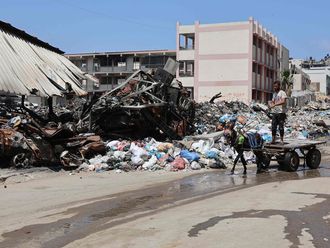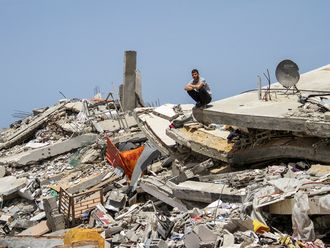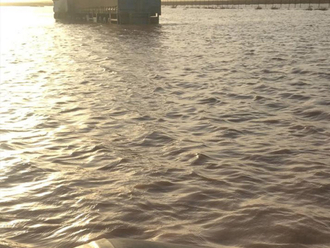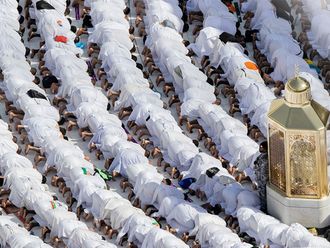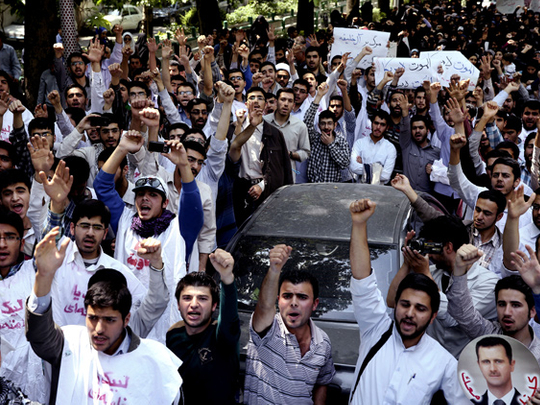
Tehran: Iran’s leaders warned of regional sectarian conflict after reports that Syrian rebels raided a shrine in a suburb of Damascus last week, destroying the site and making off with the remains of the revered Muslim figure buried there.
The shrine belonged to a companion of the Prophet Mohammad (PBUH), Hajr Bin Adi. The shrine was a site of religious significance for Shiites.
It was impossible to independently verify the report, which appeared on a Facebook page on April 28. Through the course of the civil war, the Syrian government and the rebel opposition have proven adept at manipulating social media to implicate each other in atrocities, trading accusations that cannot be substantiated.
Pictures posted on Facebook seemed to show that the sanctuary had been ransacked. The caption next to the photo reads: “This is the shrine of Hajr Bin Adi Al Kindi. It’s one of the Shiite shrines in Adra Al Balad. The heroes of the Free Syrian Army scavenged the grave and buried him in an unknown place. Praise be to God and God grant victory to the Free Syrian Army.”
The caption gives credit for the exhumation to a man named Abu Anas Al Wazir, or Abu Al Baraa, a leader of a military group called the Islam Brigade of the Free Army.
Iran’s supreme leader, Ayatollah Ali Khamenei called the event “bitter and sad,” and blamed foreign intelligence agencies for the destruction of the shrine.
Iranian and Syrian students protested against the raid on Monday in Tehran, shouting “death to America” and “death to Israel,” while pro-government speakers blamed Britain as a former coloniser for “sowing the seeds of discord between Sunnis and Shiites.”
The students shouted back, “Stop, stop the exhuming of graves.”
The Al Qaida-inspired Nusra Front claimed responsibility for the raid. Their attack was followed by a stern warning from Hassan Nasrallah, the leader of Hezbollah, the Lebanese resistance movement, who on April 30 told rebels not to target the largest Shiite sanctuary in Syria, the golden-domed shrine of Sayida Zeinab, Prophet Mohammad’s (PBUH) granddaughter.
Nasrallah warned of “very serious repercussions” if Syrian rebels attacked the shrine.
Such an attack would unleash an uncontrollable conflict, Nasrallah said, invoking a fearsome precedent: the destruction of a Shiite shrine in the Iraqi city of Samarra in 2006 that contributed to years of sectarian bloodletting.
Fighting has engulfed areas around the Syrian shrine, which is outside Damascus, and many Shiite fighters — Syrian as well as Iraqi and Lebanese — have rushed to defend it, according to fighters interviewed in Syria.
Iranian news media reported that a Shiite gathering centre close to the shrine of another revered Shiite figure, Jafar Ibn Abi Talib, in the Jordanian town of Southern Mazar was burned down on Friday.
Iranian officials blamed the US and Israel, saying they were supporting the Syrian rebels and extremist forces in the region.
“They have launched a war between Shiites and Sunnis,” Iran’s President, Mahmoud Ahmadinejad, said on Sunday. “They plant bombs in Pakistan and Iraq, and recently the Zionist regime has hit Syria. We should be careful about colonisers and Israel.”
Iran’s ideological narrative is that Western powers and Iran’s enemies in the region deliberately mislead the sects. Its leaders blame ultraconservative elements who, they say, are backed by the US and Israel, through their regional allies.
Mojtaba Bigdeli, a former leader of a Shiite pressure group, reacted angrily to reports of the raids. “We respect Sunni shrines. We do not desecrate them. We may form self-sacrifice battalions to react to the Wahhabis and Salafists in Syria. For sure we will not remain silent.”


